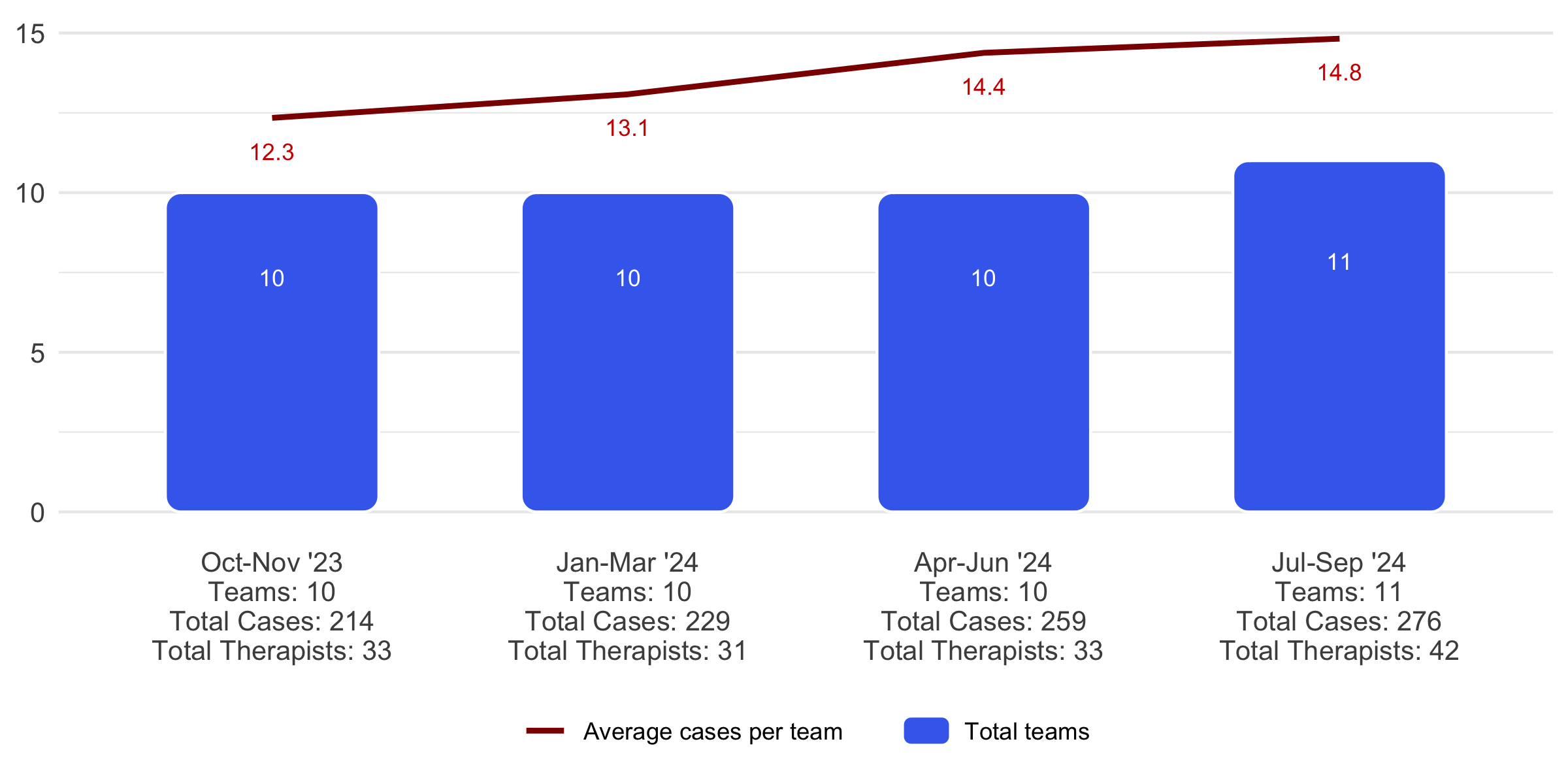

Statement of Purpose
Functional Family Therapy (FFT) is an evidence-based program (EBP) for youth ages 11-18 exhibiting behavioral or emotional problems and their families. The current report is prepared by the Center for Evidence-based Partnerships in Virginia (CEP-Va) and presents relevant fidelity and outcome data in Virginia per the Family First Prevention Services Act (FFPSA) from July 1, 2024, through September 30, 2024.
The CEP-Va Fidelity Model for FFT
CEP-Va has developed fidelity and outcome models for fidelity reporting for all evidence-based programs in the Family First Prevention Plan developed by Virginia’s Department of Social Services (VDSS) and approved by the Administration for Children and Families. For each model, we used the empirical literature and recommendations from the treatment developer. Pragmatic issues were also considered when developing the models, including data availability and burden on provider companies, practitioners, and/or families. All final models were approved by the EBP developer or the EBP training company selected by VDSS. Model is detailed here.
Historical Status of Virginia FFT Team Workforce and Caseloads
Team and Case Data
Figure 1. Active Teams with Average Caseload Across Virginia
This quarter, the total number of FFT teams with at least one active FFT case across the state was 11. The average number of active and closed cases per team in this quarter rose to 14.8, as seen in Figure 1.
Note: All teams have agreed to release their data for these reports. Accordingly, this team is now included in all sections of this report, and is why no “new” team is recorded in Table 1.
A more detailed breakdown of team statuses maintains this stability across quarters, as seen in Table 1.
Table 1. Team Status Detail
| Quarter | Teams operating | New teams | Closed teams |
|---|---|---|---|
| Jul-Sep 2021 | 9 | 0 | 0 |
| Oct-Dec 2021 | 9 | 0 | 0 |
| Jan-Mar 2022 | 10 | 1 | 0 |
| Apr-Jun 2022 | 9 | 0 | 1 |
| Jul-Sep 2022 | 9 | 0 | 0 |
| Oct-Dec 2022 | 9 | 0 | 0 |
| Jan-Mar 2023 | 9 | 1 | 1 |
| Apr-Jun 2023 | 9 | 0 | 0 |
| Jul-Sep 2023 | 10 | 1 | 0 |
| Oct-Dec 2023 | 10 | 0 | 0 |
| Jan-Mar 2024 | 10 | 0 | 0 |
| Apr-Jun 2024 | 10 | 0 | 0 |
| Jul-Sep 2024 | 11 | 0 | 0 |
Full-time Therapists
Figure 2. Average Number of Team Therapists
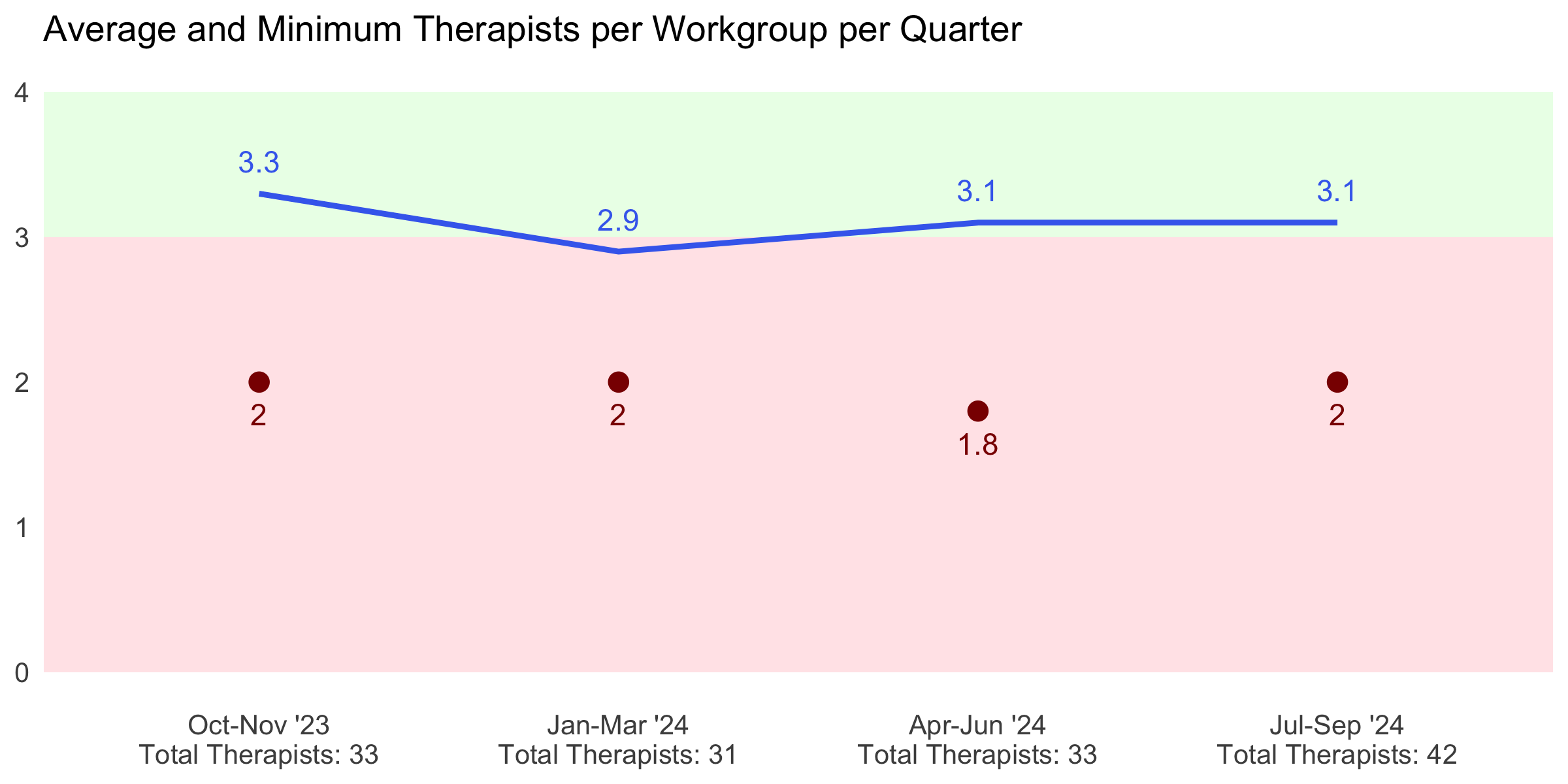
FFT, LLC, the training organization for the model, has set a target of three therapists per team, represented in the green area of Figure 2. In Q3 2024, the average number of therapists per team, weighted for the number of days they served on the team in the quarter, remained 3.1.
Cases per Therapist
Figure 3. Average Number of Cases per Therapist
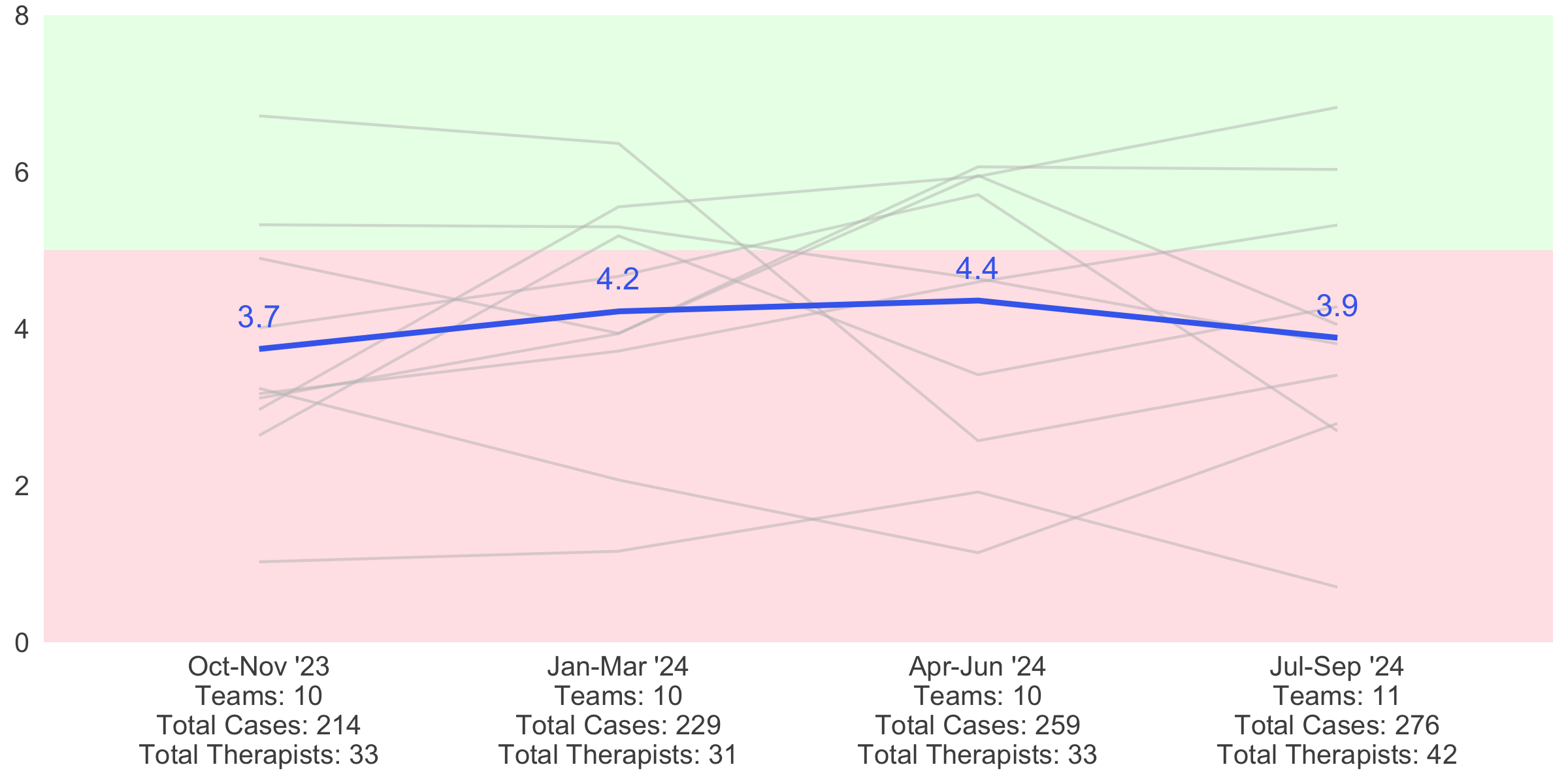
FFT, LLC expects therapists to carry a caseload between 5 and 15 cases, as represented by the green band. Figure 3 depicts each team’s average number of cases per therapist (gray lines), and the average across the state (blue line).
Cases are weighted by the number of days the case was active in the quarter.
Measure of Final Fidelity using Clinical Adherence and Clinical Competence Ratings
Fidelity Scores Across Teams
Figure 4. Average Final Fidelity Scores Across Virginia Teams
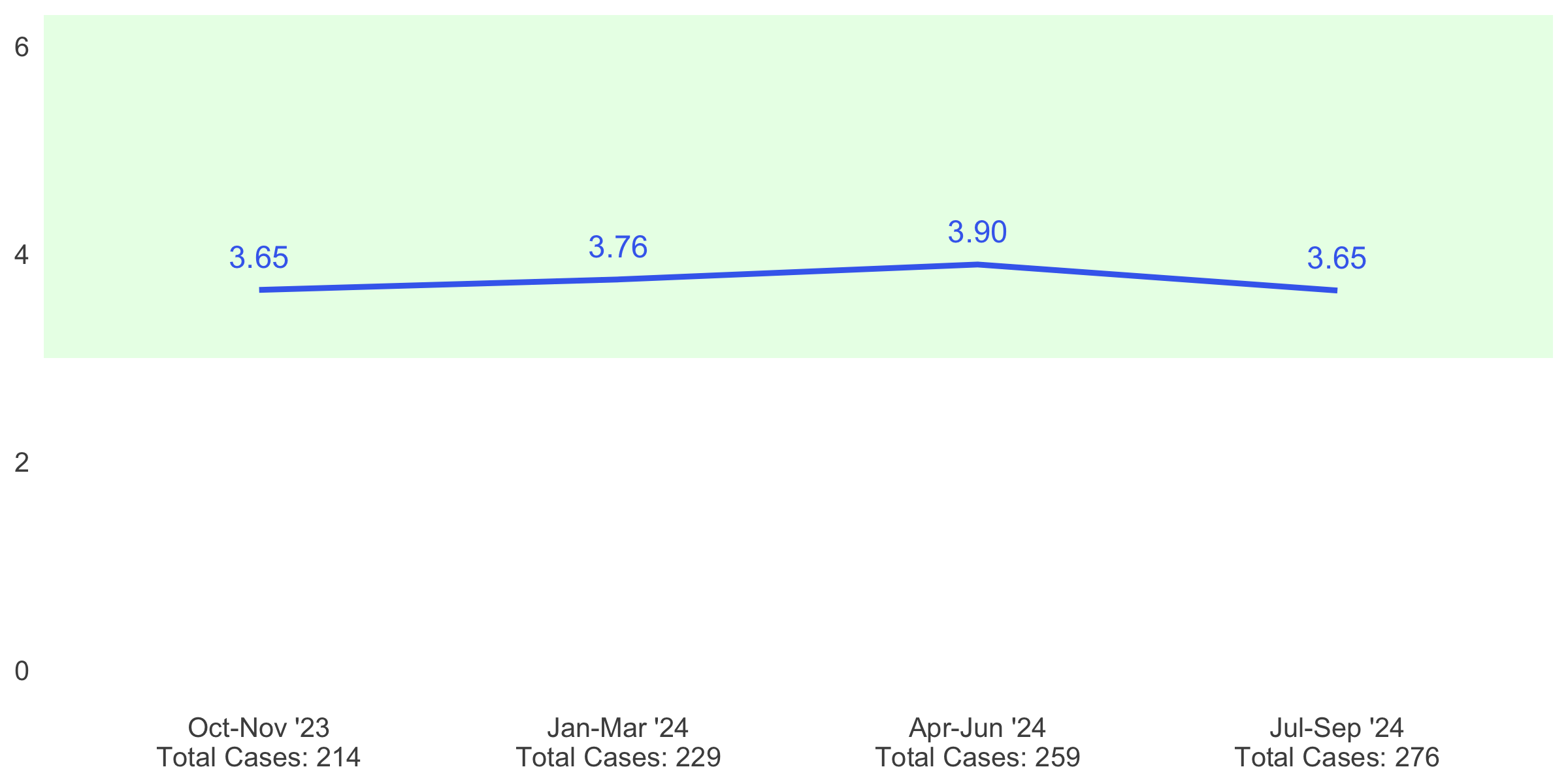
The final fidelity score is a combination of a clinician’s clinical adherence score, or how well the clinician applies the model components in the proper sequence, with the clinical competence score, or how skillfully the clinician applies the model. These ratings are given by supervisors during weekly case reviews, with an acceptable level of fidelity considered 3.0 or greater (on a 6-point scale), represented by the green area in Figure 4. The average fidelity score of all cases in the state for each quarter is depicted by the blue line, which dipped slightly to 3.65.
Figure 5. Percent of VA Teams with Average Final Fidelity Score Meeting or Exceeding the FFT Target
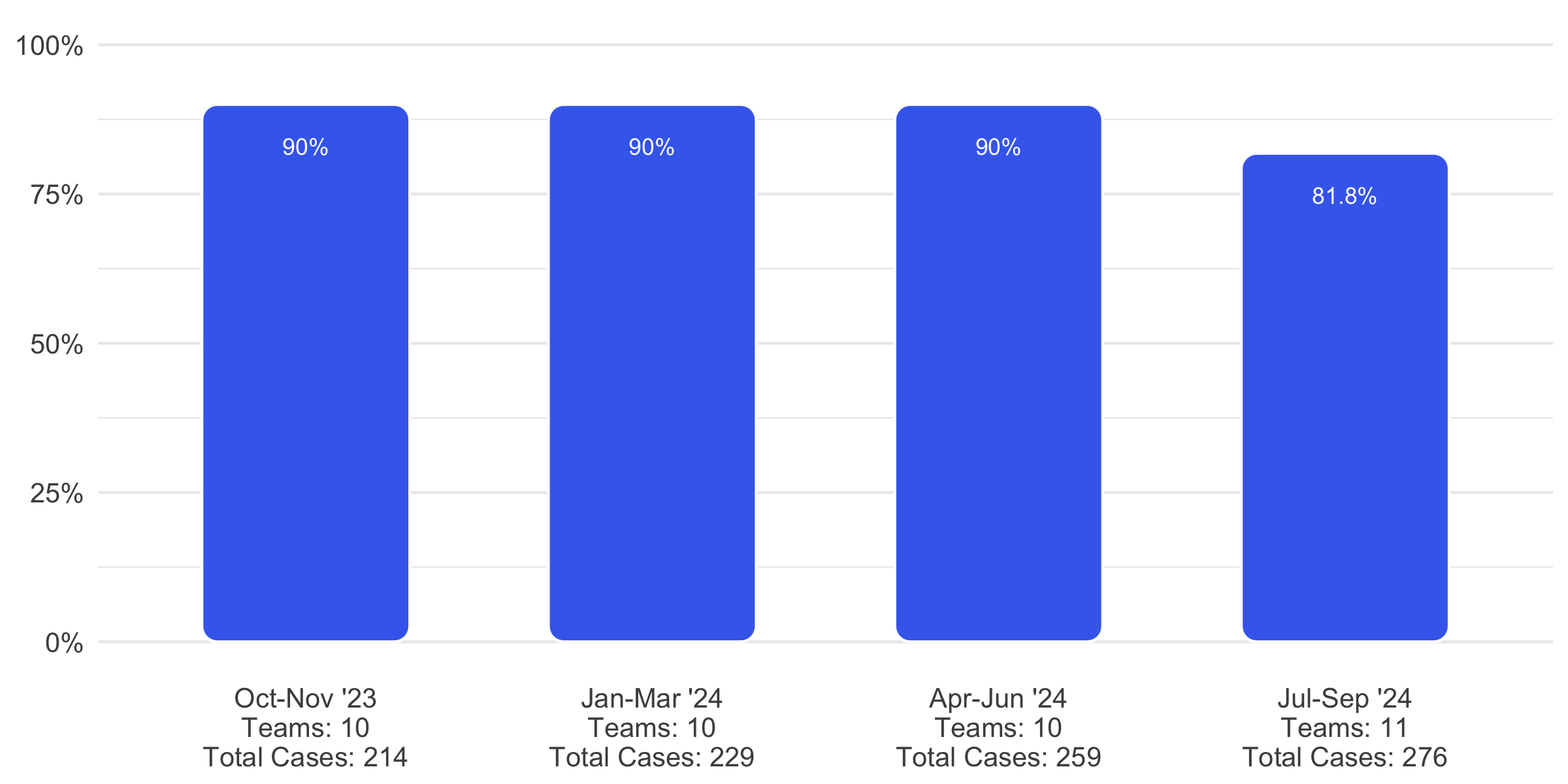
Another way to consider fidelity data is depicted in Figure 5: the percentage of teams averaging the FFT, LLC final fidelity score of 3.0 or higher in a given quarter. This quarter, 82% of teams maintained an average fidelity above the threshold.
Outcome Measures
Data for all families are included whether or not their treatment was completed in a planned fashion. Exceptions to this include cases withdrawn for funding reasons, cases where the family moved out of the service area, cases where referral sources referred a case elsewhere, or with placements that resulted from actions carried out before the start of treatment.
Remaining in Community
Figure 6. Percent of VA Youth Remaining in Community
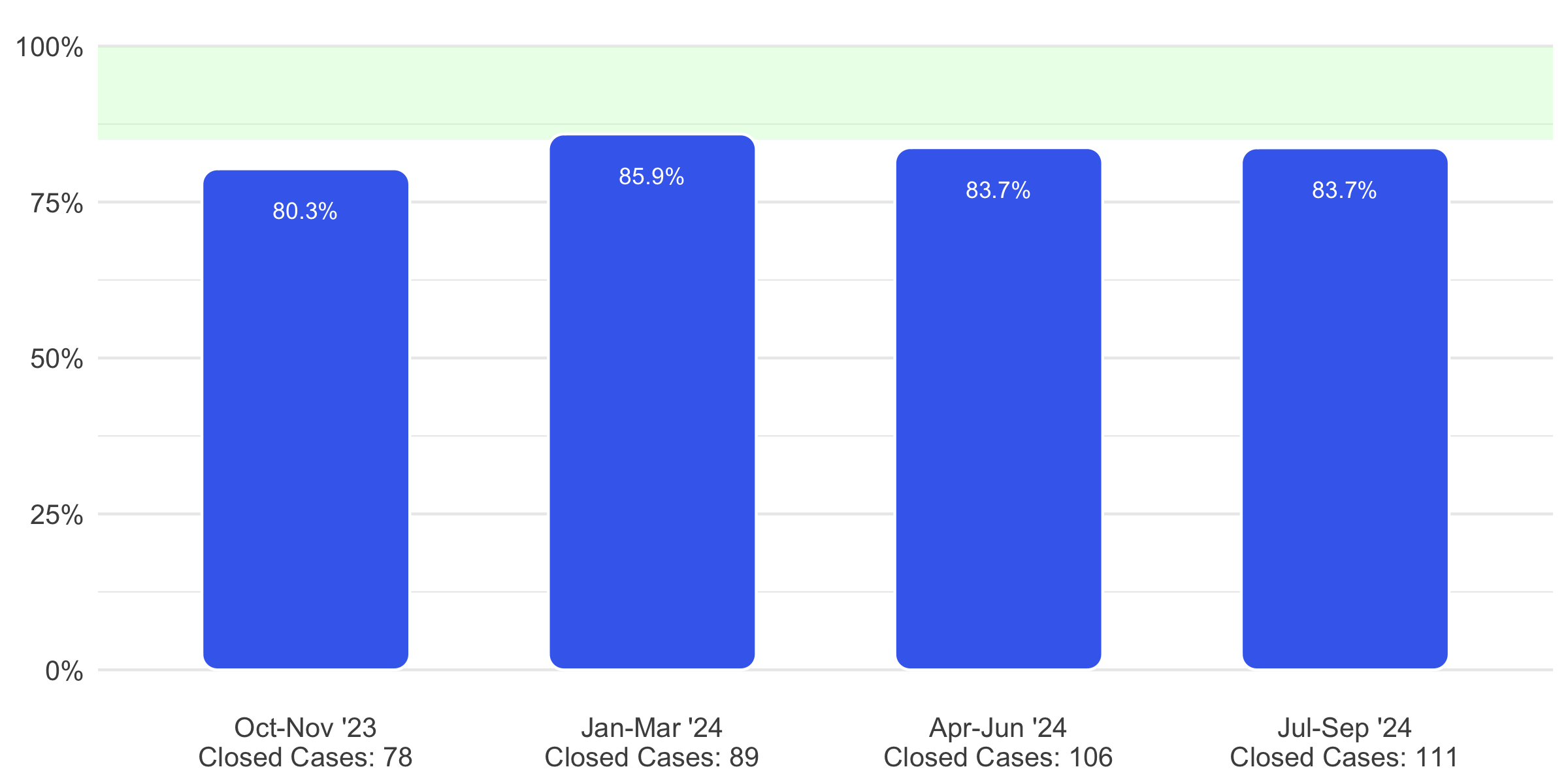
FFT, LLC defines remaining in community as not being placed formally outside of the home (group home, foster home, addiction treatment facility)but may be living with a relative in the community. This quarter, 84% of youth who completed treatment lived in the community at time of discharge.
Attending School
Figure 7. Percent of VA Youth Attending School
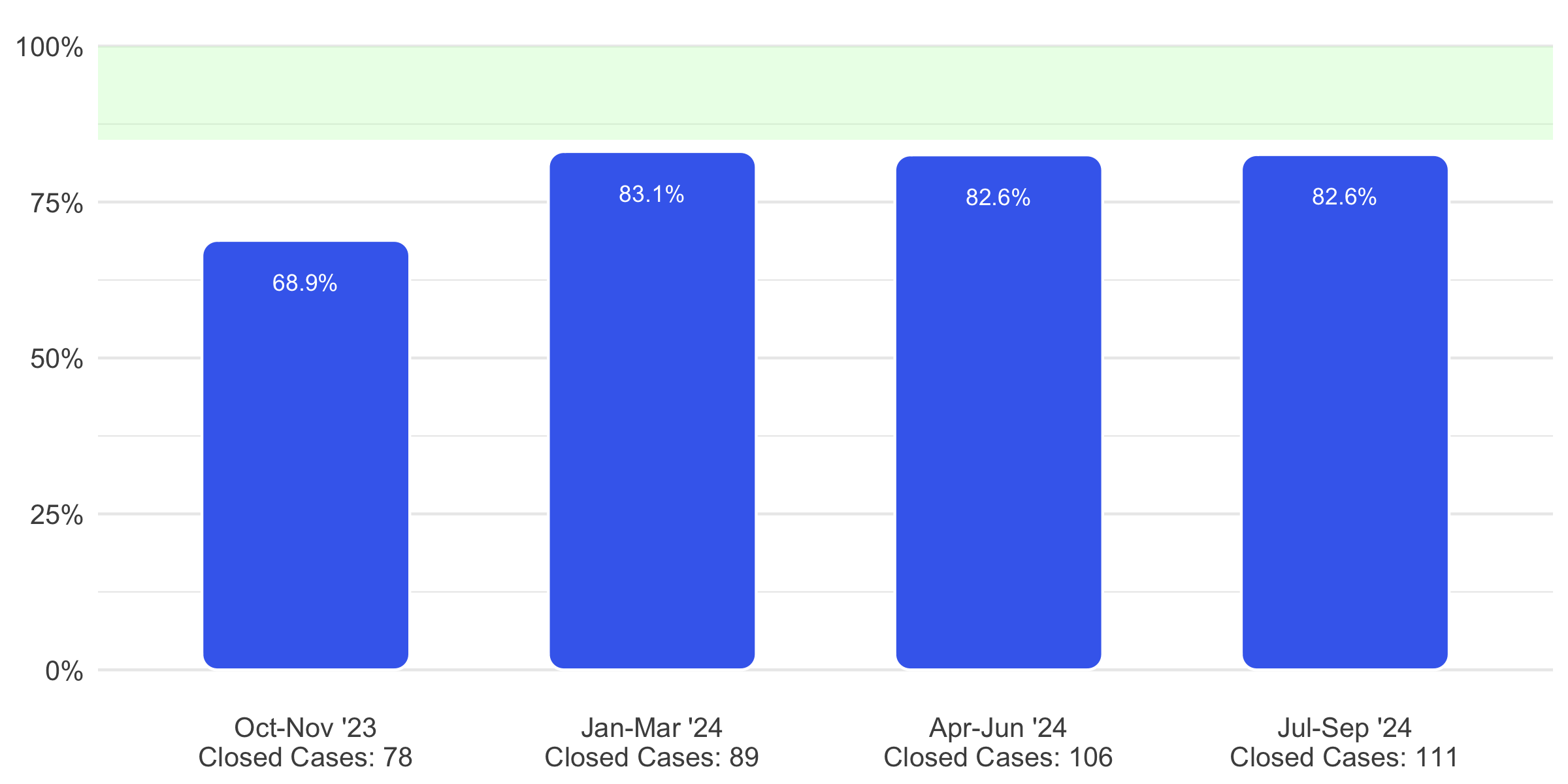
For this indicator, a youth is included if they are attending school or vocational programs, or intend to (in the cases of summer or applying to college). The share of youth attending school or work this quarter is 83%.
Law Violations
Figure 8. Percent of VA Having No New Law Violations
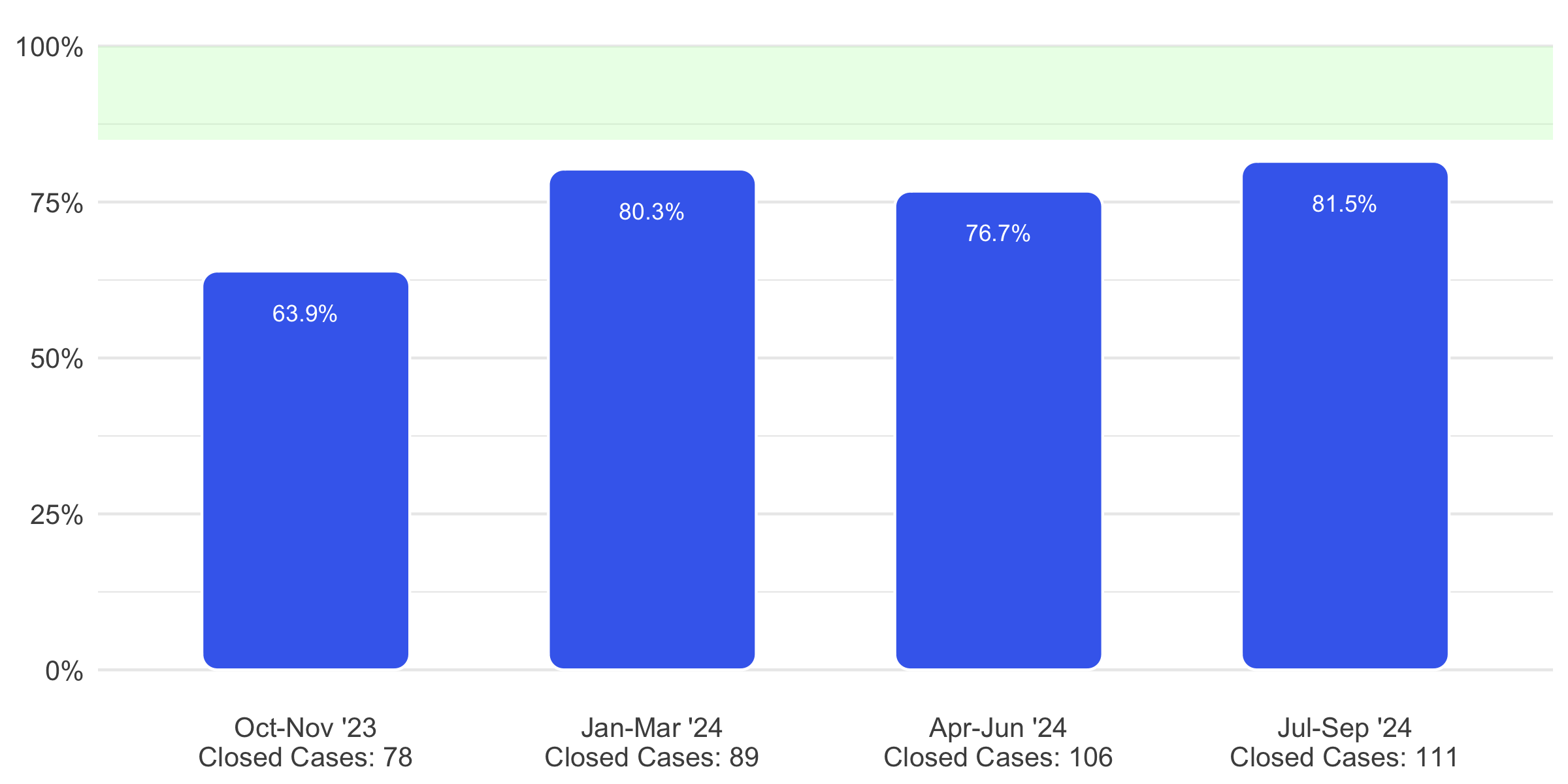
Figure 8 illustrates the share of youth having no new arrests, either when counseling finished or if treatment ended for a reason within the therapist’s control. During this reporting period, that number rose slightly to 82%, 3 points below the FFT, LLC goal of 85% of youth.
Funding Source
Figure 9. Funding Source for All Active and Closed FFT Cases in Virginia
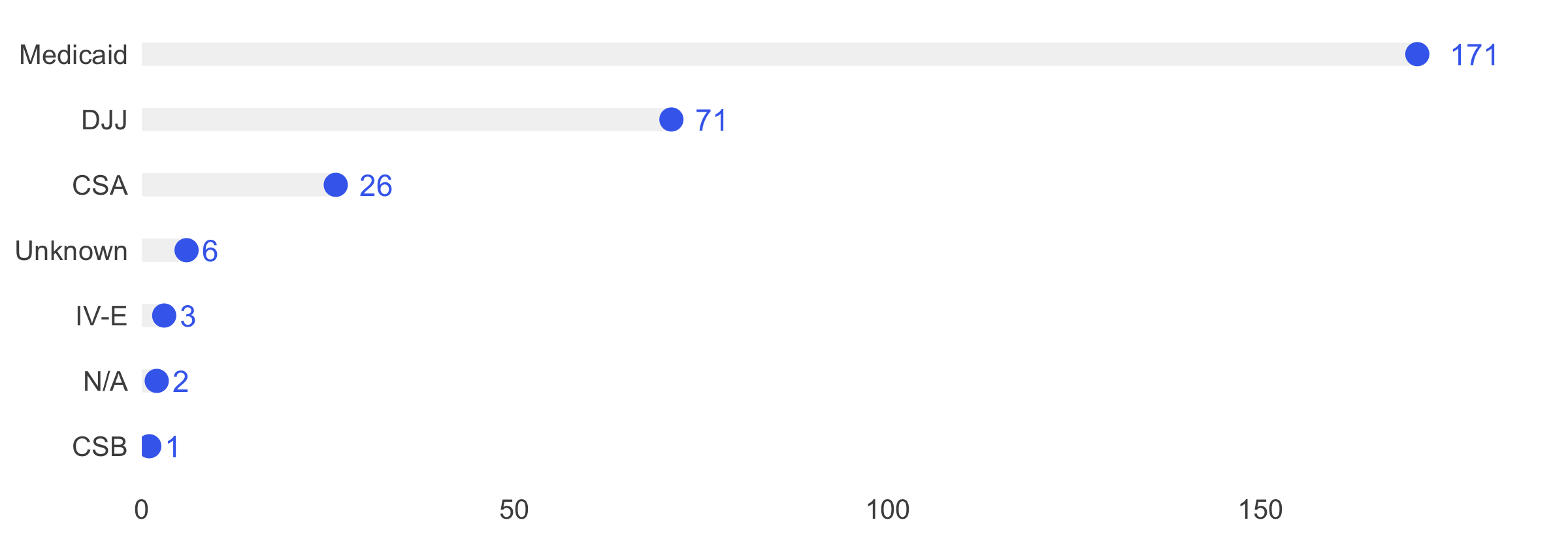
Figure 9 displays data on the number of cases funded by major payors in the state, as reported by provider companies. The top two payors are Medicaid, which funded 61% of all cases, and the Department of Juvenile Justice, which funded 25%.
Figure 10. Funding Source in Virginia Across Four Quarters
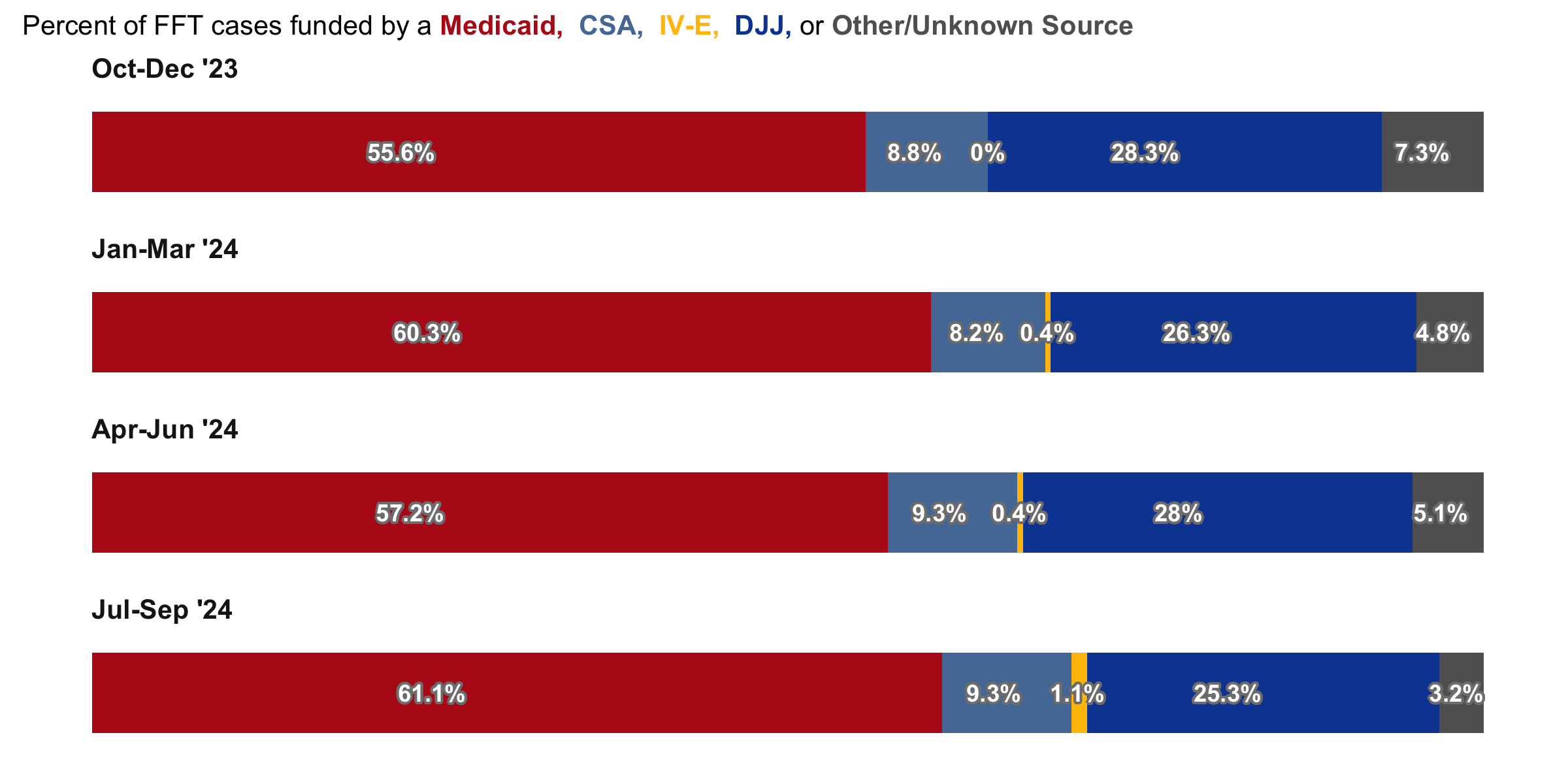
Figure 10 illustrates that during this time period, provider agencies reported that between 0 and 1.1% of cases were funded with Title IV-E funding.
Demographic Information
Table 2. Reported Age, Gender, and Race of Youth Receiving Treatment from January to March 2024
| Characteristic | n | % |
|---|---|---|
| Age | ||
| 10-13 | 76 | 27.5 |
| 14-16 | 134 | 48.6 |
| 17-19 | 64 | 23.2 |
| Unknown | 2 | 0.7 |
| Gender | ||
| Female | 114 | 41.3 |
| Male | 157 | 56.9 |
| Nonbinary, self-described, or other | 5 | 1.8 |
| Race | ||
| Bi-Racial | 17 | 6.2 |
| Black | 63 | 22.8 |
| Spanish origin, Hispanic, or Latino | 19 | 6.9 |
| Unknown or other | 31 | 11.2 |
| White | 146 | 52.9 |
Service Coverage Area
Figure 11. Provider-reported Service Coverage Areas
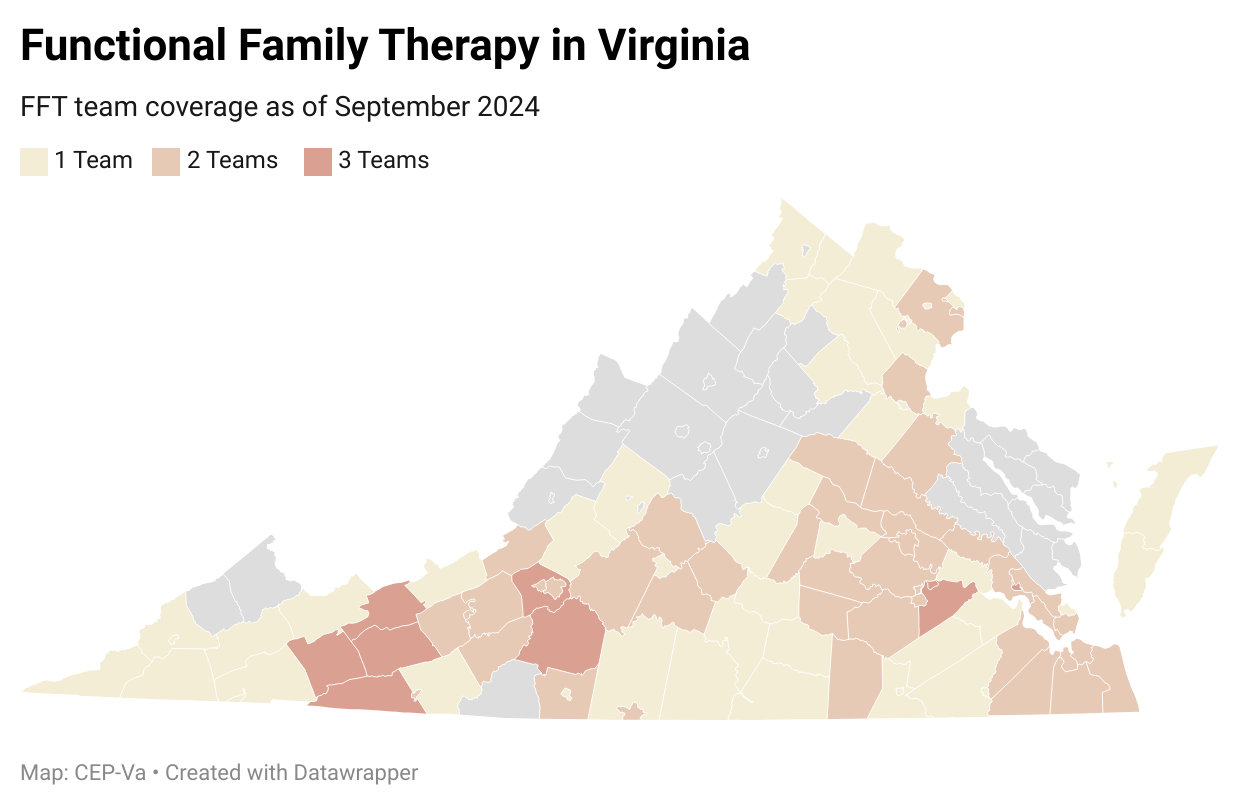
Figure 11 displays the areas in the state covered by open and staffed FFT teams. This data is collected quarterly from provider agencies and reflects the localities from which teams can accept FFT referrals for any of the major funding sources.
2/4/25 update: Fixed typos in figure numbers.